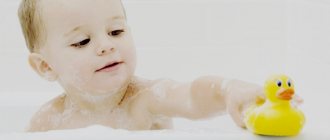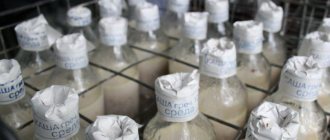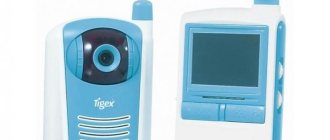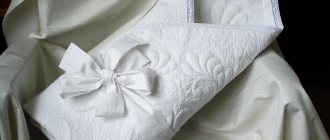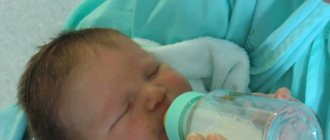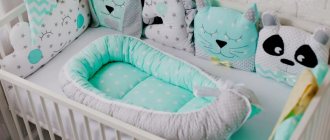Types of baths for babies
Bathtubs differ not only in color, but also in shape, dimensions, material of manufacture, and additional functions. Many types of containers designed for bathing babies are convenient and practical. The description of each model notes its advantages and disadvantages.
Plastic
Conventional bathtubs, which are made from inexpensive plastic, are popular. They are strong and durable. The baths are wide and roomy, so they are suitable not only for infants, but also for older children. For regular models, you need to additionally purchase separate bathing accessories, for example, a slide.
Anatomical
This model initially includes a built-in slide that follows the curves of the body and has an emphasis for the butt. Bathing becomes comfortable and safe.
You don't have to worry about your baby slipping and swallowing water even if you don't hold him.
The product is used not only for babies. The slide takes up part of the space, so an older child can easily fit on the other side. But a child will no longer be able to swim and play in such a container.
Requirements for the bath
If you have already chosen a model for swimming, then before purchasing it is worth inspecting the product again. Please pay attention to the following points:
- the surface of the product must be smooth, without flaws;
- the bottom of the container should not be too slippery;
- it is easier to keep the container clean without protruding parts and bends;
- it is better to choose a wide and not too short product, where a grown-up baby could play and swim freely;
- convenient if the kit includes a stand for the bathtub or the floor;
- the presence of a drain will ensure easy replacement of water.
It is recommended to buy the product in a network of well-known specialized children's stores, where a wide range of products is presented and there is an opportunity to study the certificate of its quality and reliability.
Criterias of choice
It is important to know how to choose the right safe and reliable model for your baby. Be sure to study the composition of the material and the presence of additional parts that ensure bathing safety.
Product material
Containers for bathing babies are made of plastic or thick rubber. A high-quality product does not contain harmful components that can cause allergic reactions. All edges and curves should be smooth and round.
Safety
The safety of your baby in the bathtub depends on how slippery the surface is. Therefore, good models have a surface with anti-slip devices. It is important that the product does not have sharp corners or edges.
Convenience and comfort of use
Convenience and comfort of use are provided by additional details. A hammock, slide, mattress, circle, or pillow will help you stay in the water without the help of your parents’ hands. For comfortable bathing, it is better to install a stand on the floor or on the sides of the bathtub. Draining will help you quickly change the water. Some models have a built-in thermometer.
Rules for hydrotherapy with pine concentrates
Baths for infants can be done at home or at a sanatorium-resort institution. The child in the sanatorium is monitored by a physiotherapist or pediatrician. Treatment is carried out in special rooms equipped with baths. For children, special small baths are used.
You can use a large bathtub, but with a special high chair for bathing. The chair allows you to hold the baby well. It is permissible to use special inflatable collars to hold the child’s head above the water.
In sanatorium and resort institutions, special pine needle concentrates are used in the form of granules, tablets, briquettes, and concentrated solution. The granules dissolve well in water. The solution is highly concentrated, so very little is required for a large bath.
If a child is dipped into a large bath, then 200 liters of water are first filled into it. Liquid temperature 35-37°C. For this amount of water you will need 8 g of granules (2 tablets). Liquid balm or concentrate (for a volume of 200 l) must be poured into 100 ml.
If the baby will bathe in a large bathtub, then special chairs and inflatable devices should be used. The child is lowered onto a high chair. If there are no special fixation devices, you need to hold the baby yourself.
To properly secure the child in the water, you need to place your right hand (if the mother is right-handed) under the child’s neck. Using your right hand you need to fix the baby’s left shoulder joint. You should not squeeze the child’s hand too hard; you can squeeze the brachial artery (the hand will turn blue).
You need to keep the baby in water with pine extract for 10-15 minutes. Longer use is not recommended, as allergies and dry skin are possible.
Coniferous water should not get into the child's eyes. If water gets into the eyes, they should be rinsed immediately with clean water. At the end of the physical procedure, you need to rinse the child well under running water. If the concentrate is poorly washed off, dryness, burning, rash, and itching of the skin are possible.
After the first physical procedure, you need to observe the baby. If a rash, conjunctivitis or other manifestations of an allergic reaction appear, you must stop treatment and consult a doctor.
In sanatoriums there are also small baths for children. They are designed for a sitting child, so no equipment is needed for such a bath. Since a baby from 6 months of age still does not sit well in the water on his own, he must be held with one hand by the right shoulder joint or by the armpits.
A course of therapy using pine baths for children consists of 10 physiotherapy procedures. Treatment is carried out every other day. You can bathe once a week. You can repeat the course after 3 months.
Carrying out physical therapy at home
Treatment can be carried out at home in the bathroom. For this it is better to purchase a bathtub. The average volume of a children's bath is 30-40 liters. For a baby from 6 months, you can purchase a 40-liter bath. You also need to purchase children's pine concentrate. It can be bought at a pharmacy. The concentrate is sold without a doctor's prescription.
To properly prepare the solution, you need to follow the proportions. 30 ml of water is poured into the bath (up to 37 ° C). Pour (2 tablespoons) or pour (10 ml) pine concentrate. Dosages are prescribed in the concentrate instructions. The child is slowly lowered into the bath. You need to hold the baby by the right shoulder joint. The baby's head rests on the forearm. Bathing lasts 10-15 minutes. After the procedure, the child is rinsed with clean water, wiped dry with a towel, and placed under a blanket.
You can make pine extract yourself at home. The solution is prepared as follows. To do this, take 500 g of cones or pine needles. Place them in a saucepan and add 4 liters of water. You need to boil the mixture for half an hour, then pass the solution through gauze (several layers). The prepared liquid is infused for up to half a day. This solution is diluted with water.
Before using pine cones and needles, you should consult a doctor. The decoction can lead to severe allergies, as the solution is very rich and fresh.
You can add sea salt to the pine needle extract. Bathing a child in pine-salt water should take no more than 10 minutes. During this type of treatment, the baby’s drinking regime must be observed. The course of treatment with pine-salt baths for infants is 10 physiotherapy procedures. You can repeat the course therapy after 3-4 months.
General rules for therapy in children
Before therapy, the child needs to be fed. Treatment begins 20-30 minutes after feeding. A hungry child will not be able to swim calmly.
If your baby has a tendency to allergies, then you need to conduct a skin allergy test. The pine needle solution is diluted in advance and moistened with it on the skin on the baby’s wrist. Observe for an hour, or better yet, a day. If no rash appears, then treatment can be carried out.
Bathing with pine additives is carried out immediately before bedtime. Since the therapy gives a good sedative effect, the child will fall asleep well after the physiotherapy procedure. There is no need to bathe your baby in the middle of the day, in the morning or 3 hours before bedtime. This can disrupt the child's routine. The baby will sleep during the day, but will not be able to sleep at night.
During bathing, you need to keep the baby in a reclining position. The water level should be located in the middle of the chest. Avoid contact of liquid with eyes and mouth.
If the baby bathes in a shared bath, then it should be thoroughly treated and washed. It is not necessary to pour a full bath, 2/3 of the bath will be enough. It is better to use a baby bath.
They try not to prescribe pine baths for newborns and babies under 6 months. A doctor may recommend baths in the presence of hypoxia, rickets, muscle spasms and other diseases. Before therapy, infants under 6 months must undergo an allergy test.
Newborns are bathed only in a baby bath. If the mother does not have experience in holding the child above the water on her own, you can use a bathing slide or a high chair. It is better to buy a chair with a rough fabric surface. This will prevent your baby from rolling off the chair into the water. Babies older than a month are held above water in the same way as newborns.
The water in the bath should not be higher than 37 °C. It is necessary to maintain the water temperature in the range from 35°C to 37°C. To accurately measure temperature, it is better to use a water thermometer. Thermometers are sold at any pharmacy. You can check the temperature with your elbow.
Rating of the best baths for babies
To understand which model of bathing container is better, you should get acquainted with the characteristics of the best products.
Baby Expert Trottolino 3 in 1
The model includes a convenient wheeled chest of drawers with three drawers, a folding changing surface and a removable bathtub. The material is reliable and safe, does not cause allergies and does not emit harmful substances.
Foppapedretti
This model is expensive, but convenient and practical. The anatomical folding bathtub is combined with a chest of drawers and a removable changing surface. The chest of drawers stands on stable legs and has three drawers. The furniture is made of high quality laminated chipboard.
Warming Waterfall
Lightweight and durable Warming Waterfall model with an additional hydromassage function. Jets of water are directed along the baby's back. The set includes a removable insert used for bathing babies. The bath has a drain hole.
Happy Baby Bath Comfort
The container contains an anatomical slide with suction cups, which prevents the child from slipping into the water. There is a drain hole. There are holes on the sides of the bath that make it convenient to store hygiene products.
Maltex
The bathtub of this brand is made of high-quality plastic. The body is lightweight but durable. There is an anti-slip mat at the bottom and a built-in drain with a plug. There is a recess for storing various items.
Hoppop "Mommy's Tummy"
The container has the shape of a barrel. The back of the container is slightly raised for comfortable holding of the head. The water remains at the required temperature for a long time. It does not require a lot of water, the child can sit without the support of an adult.
"Oceanic"
The bath is made of translucent plastic. The material is safe and hypoallergenic. The bottom is flat, with a pattern. There is a shelf for storing items. It is easy to care for and takes up little space. There are no sharp bends or edges.
Bath for a newborn. And all about the first bath.
Bathtubs for bathing in a wide range on our website.
Young parents have many questions about how to properly care for their baby. It is quite understandable why parents are nervous before their baby’s first bath, because he is still so small and it seems that even a slightly careless movement can harm him. In addition, babies are quite mobile, so the child must be held firmly and at the same time gently. But once you get used to bathing your child, it will become an enjoyable daily procedure for you and your child, which you will do without thinking. At first, the child may not like bathing at all, but over time this will pass. Useful tips for buying a baby:
— You need to bathe your child in a warm room, not necessarily a bathroom.
Make sure there are no drafts. - Sponge and towels should only be used for bathing your baby, they should be kept clean and should not be used by anyone. - Choose a regular time for bathing your baby, do not bathe him when he is hungry or immediately after eating. - If you are working parents, then bathing in the evening will become a good tradition in order to spend more time with your child - this will make the bathing process more enjoyable and interesting for the child. — Before bathing your child, place all the supplies you will need nearby so that everything is at hand at the right time. It is best to bathe your baby at the same time
before one of the evening feedings or half an hour to an hour before bedtime for older babies.
The optimal air temperature in the bathroom is about 24-26°C, but not lower than 21°C. Before you start swimming, measure the water temperature with a thermometer. It should be about 37°C. Hotter water can lead to overheating of the baby, and in colder water he will simply freeze - as a result, the child may begin to be capricious, and bathing from a pleasant procedure will turn into a problem. Although experience shows that the comfortable temperature for different babies may differ. I advise you to select the temperature in such a way that your hand (bring the back of your hand to the stream of water) is comfortable, then the baby will feel good in the water. Add a bathing product to the water that is approved for use from the first days of your baby’s life. Mild liquid products are suitable for daily use. Be careful when using traditional bar soap when bathing your baby. Dermatological specialists have long been convinced that ordinary hard soap, which has proven itself as a good cleanser, can have a negative effect even on the skin of an adult, not to mention the delicate skin of children. Experts explain the disadvantages of solid soap as follows. Human skin has a protective film (hydrolipid mantle) that prevents the sun, wind, water and other external aggressive factors from affecting the skin. In babies, the protective film is very thin, because its formation ends only after the third year of life. The skin pH level of newborns is 5.5, and within a few months it changes to 6.5 (slightly acidic). It is this indicator that provides the best antimicrobial protection. Ordinary hard soap has a pH level of 10, and even special softening additives reduce it only to 7. The alkaline components it contains simply “erase” the protective film. This means that the risk of infection on sensitive baby skin increases. The baby's body tries to restore the protective layer and attracts moisture from the deep layers of the skin to the surface. This starts the process of deep drying of thin, delicate baby skin, which intensifies with each time the soap is used. This results in dry and flaky skin. Soft, soap-free foams and cream-gels effectively remove water- and fat-soluble contaminants from the surface of the baby’s skin, while maintaining the natural protective layer. Such gentle cleansing prevents irritation and dryness, and also helps maintain the protective function of delicate baby skin. The duration of bathing changes with age.
Newborn babies should bathe for only about 5 minutes, and at 3-4 months, bathing time increases to 12-15 minutes. So, let's start: - Pour the required amount of water into the bath.
Add a few drops of foam shampoo to the water and stir it. - Undress the baby and carefully lower him into the water: the back of his head should be above your left wrist (if you are right-handed), while your hand holds the baby by the shoulder farthest from you. Use your other hand to wash the baby. - Use your free hand to gently pour water over your baby. If your baby is tense or crying, smile and talk to him gently. But if the child continues to cry, it is better to stop the procedure. Perhaps tomorrow bathing will bring him much more joy. - Sometimes, during the first baths, it makes sense to immerse the baby in the bath in a diaper and unwrap it in the water, so babies are less afraid of changes in temperature. For bathing you will need:
- A baby bath (or a large bath if the child is older) - A jug or ladle for rinsing - A thermometer for water - Children's bathing foam and shampoo (preferably without tears) - A large bath towel with a hood, very convenient for older ones terry robe with hood.
Before you start swimming, you need to prepare the following things:
- Clean underwear (vest, rompers, socks, hat) - Clean cotton diaper - Diapers or swaddling pads.
— Cotton swabs, disks, balls — Hydrogen peroxide solution, 2% solution of brilliant green (brilliant green), alcohol (if the navel has not yet healed) — Baby diaper cream — Baby cream or baby oil — Hair brush For older children: — Clean panties, T-shirt, pajamas.
— Baby cream or milk, comb Apply a small amount of foam shampoo to your hand, lather and start washing. You need to wash your baby sequentially: neck, chest, stomach, arms and legs, back and only then head. Thoroughly rinse the folds of the neck, armpits, groin, elbows and knees. Don't forget to open and wash your clenched fists.
The child's head is washed daily, since babies tend to sweat a lot. Using shampoo, wash your hair 1-2 times a week. Tilt the baby's head back, holding it with your palm. Pour water over your hair from the face to the back of the head and apply and lather a few drops of foam or shampoo. Massage your scalp and then gently rinse off the foam using washing movements from your face to the back of your head.
Now you can rinse your baby with water from a jug, which should be about 1°C cooler than the water in the bath.
Wrap the baby in a towel and place him in clean diapers.
Blot (but do not wipe) first the baby's head and then the baby's body. All folds of the skin must be thoroughly dried.
Treat the umbilical wound. If the wound has not yet healed, after bathing it should be lightly blotted with a towel. Then take a cotton swab and moisten the wound generously with a 3% hydrogen peroxide solution, remove excess moisture with a clean cotton swab. Use another cotton swab dipped in a solution of brilliant green to treat the navel. Or follow your pediatrician's recommendations.
Treat all wrinkles on your baby's body with baby moisturizer or oil.
Treat the crotch folds and diaper area with baby diaper cream or powder. Do not apply cream and powder to the same areas of the skin at the same time. Put on the diaper and dress the baby. Don't forget your cap. What to bathe in?
It is very important to prepare in advance a comfortable place for the child to bathe.
To avoid an uncomfortable position while swimming, use special stands. Some designs include, in addition to bathtubs, also changing tables and shelves for accessories. These are a kind of “autonomous systems” that have everything necessary for bathing and changing a baby; they can be installed anywhere in the apartment. Anatomical bathtubs are distinguished by the fact that their bottom has a special shape that supports the child in a comfortable position. In ordinary baths, you can use stands (“slides”), nets, mattresses, which serve the same purpose and make it easier for parents to bathe their baby. When the baby begins to sit, many people use a large bathtub. To prevent him from slipping, you need a special mat, preferably with suction cups. What to bathe with? For bathing you need:
Baby foam. Look at the label: it indicates what age it is for. It’s good if there is a mark - hypoallergenic and does not contain fragrances or dyes. Baby shampoo (however, you can also wash your hair with baby foam). Baby oil (if your head is covered with crusts, grease them with oil; when they soften, brush them with a baby hair brush). Baby soap (makes sense in extreme cases when dirt is visible to the naked eye).
Soft mitten or natural sponge.
Bath toys to
a) the child was not bored and
b) he was distracted and thrashed his feet less in the water. How to hold it? The most important thing is to keep your child in the water so that neither you nor he is afraid. If you feel insecure, it’s better not to start - the child will also feel in danger and will be capricious. The head and shoulders should rest on your forearm, and your hand should be under the baby's armpit (unless you are using accessories to support the baby in the bath). Mandatory rules:
1. Until the child’s belly button heals (about two weeks of age), either you don’t need to bathe him at all, or bathe him in boiled water with the addition of a solution of potassium permanganate (the water should be slightly pink in color).
2. Never leave small children unattended in the bathtub, even after they have learned to sit, stand or walk. 3. If the baby is lying on the changing table, do not be distracted, do not turn away or move away from him. Children are very fidgety creatures. I would like to keep them intact. 4. Make sure there are no drafts. 5. Try not to pour water on your child's face (children hate this). It is better to wipe your face separately. Washing and cleaning the nose.
In the morning before feeding, you need to use a piece of cotton wool (it’s most convenient to roll out more cotton balls in advance or buy ready-made ones) to wash the baby’s face with boiled water at room temperature and carefully dry with a clean napkin or handkerchief.
Please note that you need to wash your eyes from the outer edge of the eye to the inner edge and to the nose, each eye separately, with one ball only once, and if you need to wash it additionally, take another clean ball. If the eyes fester or become watery, wash the healthy eye first, then the diseased one. Dry the eyes with dry pieces of cotton wool or disks, separate for each eye, or with a soft, clean napkin. To clear your child’s nose, you must first drop one drop of saline solution into each nostril (for example, Aqualor, Aquamaris, Salin). You can even use regular pharmaceutical saline solution. It is not recommended to prepare saline solutions for children at home - they are prepared in distilled sterile water with precise adherence to proportions and hygiene rules; this cannot be achieved at home. So, we drip 2-4 drops into each nostril and wait (you can play fetch for now), after a few minutes the crusts soften and are easily removed with a cotton swab (and never a stick!) dipped in the same solution. After instillation, some children begin to sneeze, sneezing out most of the crusts on their own - all you have to do is remove the remaining ones with a flagellum. Carefully screw the flagellum into the nasal passage 1-1.5 cm, turn it slightly and remove it. Previously, there were recommendations to clean with nossterile oil, but recently this has been abandoned. The oil disrupts the functioning of the ciliated epithelium of the nasal mucosa, which complicates its normal functioning and can even cause swelling of the mucous membrane. We clean our ears.
It is necessary to wash the child's ears very carefully so as not to pour water into the ear canal. This is done with a cotton ball soaked in boiled water and wrung out. Each ear has its own separate ball - do not forget the area behind the ears, desquamated epithelium often accumulates there, which causes irritation. If a lot of wax accumulates in the child’s ear canal, you need to carefully clean it out with a flagellum (again, not with a stick!). But the flagellum should not be inserted deeply, so as not to damage the delicate membranes of the ear canal.
PS You can purchase baths for children on our website.
